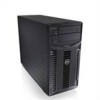Dell PowerEdge T410 Hardware Owner's Manual - Page 196
board or may be an expansion card that plugs into an expansion slot. - volts
 |
View all Dell PowerEdge T410 manuals
Add to My Manuals
Save this manual to your list of manuals |
Page 196 highlights
termination on these devices by changing jumper or switch settings on the devices or by changing settings in the configuration software for the devices. TOE - TCP/IP offload engine. U-DIMM - An unregistered (unbuffered) DDR3 memory module. uplink port - A port on a network hub or switch used to connect to other hubs or switches without requiring a crossover cable. UPS - Uninterruptible power supply. A battery-powered unit that automatically supplies power to your system in the event of an electrical failure. USB - Universal Serial Bus. A USB connector provides a single connection point for multiple USB-compliant devices, such as mice and keyboards. USB devices can be connected and disconnected while the system is running. USB memory key - See memory key. utility - A program used to manage system resources-memory, disk drives, or printers, for example. V - Volt(s). VAC - Volt(s) alternating current. VDC - Volt(s) direct current. VGA - Video graphics array. VGA and SVGA are video standards for video adapters with greater resolution and color display capabilities than previous standards. video adapter - The logical circuitry that provides (in combination with the monitor) your system's video capabilities. A video adapter may be integrated into the system board or may be an expansion card that plugs into an expansion slot. video memory - Most VGA and SVGA video adapters include memory chips in addition to your system's RAM. The amount of video memory installed primarily influences the number of colors that a program can display (with the appropriate video drivers and monitor capabilities). video resolution - Video resolution (800 x 600, for example) is expressed as the number of pixels across by the number of pixels up and down. To display a program at a specific graphics resolution, you must install the appropriate video drivers and your monitor must support the resolution. virtualization - The ability via software to share the resources of a single computer across multiple environments. A single physical system may appear to the user as multiple virtual systems able to host multiple operating systems. 194 Glossary















